Transcriptome Analysis of the Salt-Treated Actinidia deliciosa (A. Chev.) C. F. Liang and A. R. Ferguson Plantlets
Abstract
1. Introduction
2. Materials and Methods
2.1. Plant Materials and Tissue Culture
2.2. Tissue-Culture Material Treatment
2.3. Sequencing Data Processing
2.4. Enrichment Analysis of Differentially Expressed Genes in the GO Database
2.5. Kyoto Encyclopedia of Genes and Genomes (KEGG) Analysis of DEGs
2.6. Real-Time Quantitative Polymerase Chain Reaction (RT-qPCR) Analysis
2.7. Determination of the Growth of A. deliciosa ‘Xuxiang’ Plantlets after Salt Treatment
2.8. Data Statistical Analysis
3. Results
3.1. Morphology of Salt-Treated Plants
3.2. The Quality of RNA-Seq
3.3. DEGs Analysis
3.4. KEGG Analysis of DEGs
3.5. RT-qPCR Validation
4. Discussion
5. Conclusions
Author Contributions
Funding
Institutional Review Board Statement
Informed Consent Statement
Data Availability Statement
Acknowledgments
Conflicts of Interest
References
- Ye, X.; Wang, H.; Cao, X.; Jin, X.; Cui, F.; Bu, Y.; Liu, H.; Wu, W.; Takano, T.; Liu, S. Transcriptome profiling of Puccinellia tenuiflora during seed germination under a long-term saline-alkali stress. BMC Genom. 2019, 20, 589. [Google Scholar] [CrossRef] [PubMed]
- Akram, M.S.; Shahid, M.; Tariq, M.; Azeem, M.; Javed, M.T.; Saleem, S.; Riaz, S. Deciphering Staphylococcus sciuri SAT-17 mediated anti-oxidative defense mechanisms and growth modulations in salt stressed maize (Zea mays L.). Front Microbiol. 2016, 7, 867. [Google Scholar] [CrossRef] [PubMed]
- Çelik, Ö.; Atak, Ç. Random amplified polymorphic DNA analysis of salt-tolerant tobacco mutants generated by gamma radiation. Genet. Mol. Res. 2015, 14, 1324–1337. [Google Scholar] [CrossRef] [PubMed]
- Primo-Capella, A.; Forner-Giner, M.Á.; Martínez-Cuenca, M.R.; Terol, J. Comparative transcriptomic analyses of citrus cold-resistant vs. sensitive rootstocks might suggest a relevant role of ABA signaling in triggering cold scion adaption. BMC Plant Biol. 2022, 22, 209. [Google Scholar] [CrossRef]
- Harfouche, A.; Meilan, R.; Kirst, M.; Morgante, M.; Boerjan, W.; Sabatti, M.; Scarascia Mugnozza, G. Accelerating the domestication of forest trees in a changing world. Trends Plant Sci. 2012, 17, 64–72. [Google Scholar] [CrossRef]
- Liu, X.; Zhang, Z.; Bian, W.; Duan, A.; Zhang, H. Enhancing the expression of ARK1 genes in poplar leads to multiple branches and transcriptomic changes. R. Soc. Open Sci. 2020, 7, 201201. [Google Scholar] [CrossRef]
- Li, Y.; Zhang, Z.; Liu, X.; Wei, Z.; Zhang, X.; Bian, W.; Li, S.; Zhang, H. Transcriptome analysis of the low temperature- treated tetraploid yellow Actinidia chinensis Planch. tissue culture plantlets. Life 2022, 12, 1573. [Google Scholar] [CrossRef]
- Quiroz-Iturra, L.F.; Simpson, K.; Arias, D.; Silva, C.; González-Calquin, C.; Amaza, L.; Handford, M.; Stange, C. Carrot DcALFIN4 and DcALFIN7 transcription factors boost carotenoid levels and participate differentially in salt stress tolerance when expressed in Arabidopsis thaliana and Actinidia deliciosa. Int. J. Mol. Sci. 2022, 23, 12157. [Google Scholar] [CrossRef]
- Hao, S.; Zhao, T.; Xia, X.; Yin, W. Genome-wide comparison of two poplar genotypes with different growth rates. Plant Mol. Biol. 2011, 76, 575–591. [Google Scholar] [CrossRef]
- Ganie, S.A.; Molla, K.A.; Henry, R.J.; Bhat, K.V.; Mondal, T.K. Advances in understanding salt tolerance in rice. Theor. Appl. Genet. 2019, 132, 851–870. [Google Scholar] [CrossRef]
- Zhang, H.; Wu, J.; Liu, X.; Wei, Z.; Zhang, Z.; Bian, W. Method for the Induction of Salt-Tolerant Mutants in ‘Xuxiang’ Kiwifruit Tissue-Cultured Seedlings. Chinese Patent ZL201910566729.8, 27 June 2019. (In Chinese). [Google Scholar]
- Che, Y.; Yao, T.; Wang, H.; Wang, Z.; Zhang, H.; Sun, G.; Zhang, H. Potassium ion regulates hormone, Ca2+ and H2O2 signal transduction and antioxidant activities to improve salt stress resistance in tobacco. Plant Physiol. Biochem. 2022, 186, 40–51. [Google Scholar] [CrossRef]
- Ahmad, M.; Li, J.; Yang, Q.; Jamil, W.; Teng, Y.; Bai, S. Phylogenetic, molecular, and functional characterization of PpyCBF proteins in asian pears (Pyrus pyrifolia). Int. J. Mol. Sci. 2019, 20, 2074. [Google Scholar] [CrossRef]
- Daldoul, S.; Hanzouli, F.; Hamdi, Z.; Chenenaoui, S.; Wetzel, T.; Nick, P.; Mliki, A.; Gargouri, M. The root transcriptome dynamics reveals new valuable insights in the salt-resilience mechanism of wild grapevine (Vitis vinifera subsp. sylvestris). Front. Plant Sci. 2022, 13, 1077710. [Google Scholar] [CrossRef]
- Hajiboland, R.; Bahrami-Rad, S.; Akhani, H.; Poschenrieder, C. Salt tolerance mechanisms in three Irano-Turanian Brassicaceae halophytes relatives of Arabidopsis thaliana. J. Plant Res. 2018, 131, 1029–1046. [Google Scholar] [CrossRef]
- Yiman, Q.; Miaomiao, L.; Kun, Y.; Mingtao, F. Effect of skin maceration treatment on aroma profiles of kiwi wines elaborated with Actinidia deliciosa “Xuxiang” and A. chinensis “Hort16A”. J. AOAC Int. 2019, 102, 683–685. [Google Scholar] [CrossRef]
- Munakata, R.; Takemura, T.; Tatsumi, K.; Moriyoshi, E.; Yanagihara, K.; Sugiyama, A.; Suzuki, H.; Seki, H.; Muranaka, T.; Kawano, N.; et al. Isolation of Artemisia capillaris membrane-bound di-prenyltransferase for phenylpropanoids and redesign of artepillin C in yeast. Commun. Biol. 2019, 2, 384. [Google Scholar] [CrossRef]
- Anders, S.; Huber, W. Differential expression analysis for sequence count data. Genome Biol. 2010, 11, R106. [Google Scholar] [CrossRef]
- Sedgwick, P. Multiple hypothesis testing and Bonferroni’s correction. Br. Med. J. 2014, 349, g6284. [Google Scholar] [CrossRef]
- Liang, K. False discovery rate estimation for large-scale homogeneous discrete p-values. Biometrics 2016, 72, 639–648. [Google Scholar] [CrossRef]
- Li, S.; Liu, X.; Liu, H.; Zhang, X.; Ye, Q.; Zhang, H. Induction, identification and genetics analysis of tetraploid Actinidia chinensis. R. Soc. Open Sci. 2019, 6, 191052. [Google Scholar] [CrossRef]
- Ku, Y.S.; Sintaha, M.; Cheung, M.Y.; Lam, H.M. Plant hormone signaling crosstalks between biotic and abiotic stress responses. Int. J. Mol. Sci. 2018, 19, 3206. [Google Scholar] [CrossRef] [PubMed]
- Boudet, A.M. Evolution and current status of research in phenolic compounds. Phytochemistry 2007, 68, 2722–2735. [Google Scholar] [CrossRef] [PubMed]
- Godwin, J.; Farrona, S. Plant epigenetic stress memory induced by drought: A physiological and molecular perspective. Methods Mol. Biol. 2020, 2093, 243–259. [Google Scholar] [CrossRef] [PubMed]
- Lanot, A.; Hodge, D.; Jackson, R.G.; George, G.L.; Elias, L.; Lim, E.K.; Vaistij, F.E.; Bowles, D.J. The glucosyltransferase UGT72E2 is responsible for monolignol 4-O-glucoside production in Arabidopsis thaliana. Plant J. 2006, 48, 286–295. [Google Scholar] [CrossRef] [PubMed]
- Kim, J.; Choi, B.; Park, Y.H.; Cho, B.K.; Lim, H.S.; Natarajan, S.; Park, S.U.; Bae, H. Molecular characterization of ferulate 5-hydroxylase gene from kenaf (Hibiscus cannabinus L.). Sci. World J. 2013, 2013, 421578. [Google Scholar] [CrossRef]
- de Oliveira, L.P.; Navarro, B.V.; de Jesus Pereira, J.P.; Lopes, A.R.; Martins, M.C.M.; Riaño-Pachón, D.M.; Buckeridge, M.S. Bioinformatic analyses to uncover genes involved in trehalose metabolism in the polyploid sugarcane. Sci. Rep. 2022, 12, 7516. [Google Scholar] [CrossRef]
- Jang, I.C.; Oh, S.J.; Seo, J.S.; Choi, W.B.; Song, S.I.; Kim, C.H.; Kim, Y.S.; Seo, H.S.; Choi, Y.D.; Nahm, B.H.; et al. Expression of a bifunctional fusion of the Escherichia coli genes for trehalose-6-phosphate synthase and trehalose-6-phosphate phosphatase in transgenic rice plants increases trehalose accumulation and abiotic stress tolerance without stunting growth. Plant Physiol. 2003, 131, 516–524. [Google Scholar] [CrossRef]
- Amirbakhtiar, N.; Ismaili, A.; Ghaffari, M.R.; Nazarian Firouzabadi, F.; Shobbar, Z.S. Transcriptome response of roots to salt stress in a salinity-tolerant bread wheat cultivar. PLoS ONE 2019, 14, e0213305. [Google Scholar] [CrossRef]
- Frukh, A.; Siddiqi, T.O.; Khan, M.I.R.; Ahmad, A. Modulation in growth, biochemical attributes and proteome profile of rice cultivars under salt stress. Plant Physiol. Biochem. 2020, 146, 55–70. [Google Scholar] [CrossRef]
- Truong, H.A.; Lee, W.J.; Jeong, C.Y.; Trịnh, C.S.; Lee, S.; Kang, C.S.; Cheong, Y.K.; Hong, S.W.; Lee, H. Enhanced anthocyanin accumulation confers increased growth performance in plants under low nitrate and high salt stress conditions owing to active modulation of nitrate metabolism. J. Plant Physiol. 2018, 231, 41–48. [Google Scholar] [CrossRef]
- Yang, Y.; Zheng, Q.; Liu, M.; Long, X.; Liu, Z.; Shen, Q.; Guo, S. Difference in sodium spatial distribution in the shoot of two canola cultivars under saline stress. Plant Cell Physiol. 2012, 53, 1083–1092. [Google Scholar] [CrossRef]
- Poór, P.; Borbély, P.; Czékus, Z.; Takács, Z.; Ördög, A.; Popović, B.; Tari, I. Comparison of changes in water status and photosynthetic parameters in wild type and abscisic acid-deficient sitiens mutant of tomato (Solanum lycopersicum cv. Rheinlands Ruhm) exposed to sublethal and lethal salt stress. J. Plant Physiol. 2019, 232, 130–140. [Google Scholar] [CrossRef]
- Bushman, B.S.; Amundsen, K.L.; Warnke, S.E.; Robins, J.G.; Johnson, P.G. Transcriptome profiling of Kentucky bluegrass (Poa pratensis L.) accessions in response to salt stress. BMC Genom. 2016, 17, 48. [Google Scholar] [CrossRef]
- Teshome, A.; Byrne, S.L.; Didion, T.; De Vega, J.; Jensen, C.S.; Klaas, M.; Barth, S. Transcriptome sequencing of Festulolium accessions under salt stress. BMC Res. Notes 2019, 12, 311. [Google Scholar] [CrossRef]
- Jin, H.; Dong, D.; Yang, Q.; Zhu, D. Salt-responsive transcriptome profiling of Suaeda glauca via RNA sequencing. PLoS ONE 2016, 11, e0150504. [Google Scholar] [CrossRef]
- Noor, J.; Ullah, A.; Saleem, M.H.; Tariq, A.; Ullah, S.; Waheed, A.; Okla, M.K.; Al-Hashimi, A.; Chen, Y.; Ahmed, Z.; et al. Effect of jasmonic acid foliar spray on the morpho-physiological mechanism of salt stress tolerance in two soybean varieties (Glycine max L.). Plants 2022, 11, 651. [Google Scholar] [CrossRef]
- Boamah, S.; Zhang, S.; Xu, B.; Li, T.; Calderón-Urrea, A.; John Tiika, R. Trichoderma longibrachiatum TG1 increases endogenous salicylic acid content and antioxidants activity in wheat seedlings under salinity stress. PeerJ 2022, 10, e12923. [Google Scholar] [CrossRef]
- Ruiz, K.B.; Maldonado, J.; Biondi, S.; Silva, H. RNA-seq analysis of salt-stressed versus non salt-stressed transcriptomes of Chenopodium quinoa Landrace R49. Genes 2019, 10, 1042. [Google Scholar] [CrossRef]
- Safdarian, M.; Askari, H.; Shariati, J.V.; Nematzadeh, G. Transcriptional responses of wheat roots inoculated with Arthrobacter nitroguajacolicus to salt stress. Sci. Rep. 2019, 9, 1792. [Google Scholar] [CrossRef]
- Nguyen, D.Q.; Brown, C.W.; Pegler, J.L.; Eamens, A.L.; Grof, C.P.L. Molecular manipulation of MicroRNA397 abundance influences the development and salt stress response of Arabidopsis thaliana. Int. J. Mol. Sci. 2020, 21, 7879. [Google Scholar] [CrossRef]
- Yuenyong, W.; Chinpongpanich, A.; Comai, L.; Chadchawan, S.; Buaboocha, T. Downstream components of the calmodulin signaling pathway in the rice salt stress response revealed by transcriptome profiling and target identification. BMC Plant Biol. 2018, 18, 335. [Google Scholar] [CrossRef] [PubMed]
- Chen, F.; Fang, P.; Peng, Y.; Zeng, W.; Zhao, X.; Ding, Y.; Zhuang, Z.; Gao, Q.; Ren, B. Comparative proteomics of salt-tolerant and salt-sensitive maize inbred lines to reveal the molecular mechanism of salt tolerance. Int. J. Mol. Sci. 2019, 20, 4725. [Google Scholar] [CrossRef] [PubMed]
- Tatevossian, A. Hydrolysis of some carbohydrate substrates by enzymes of pooled human dental plaque fluid. Arch. Oral Biol. 1982, 27, 39–43. [Google Scholar] [CrossRef] [PubMed]
- Kerimi, A.; Nyambe-Silavwe, H.; Pyner, A.; Oladele, E.; Gauer, J.S.; Stevens, Y.; Williamson, G. Nutritional implications of olives and sugar: Attenuation of post-prandial glucose spikes in healthy volunteers by inhibition of sucrose hydrolysis and glucose transport by oleuropein. Eur. J. Nutr. 2019, 58, 1315–1330. [Google Scholar] [CrossRef]
- Miranda, J.A.; Avonce, N.; Suárez, R.; Thevelein, J.M.; Van Dijck, P.; Iturriaga, G. A bifunctional TPS-TPP enzyme from yeast confers tolerance to multiple and extreme abiotic-stress conditions in transgenic Arabidopsis. Planta 2007, 226, 1411–1421. [Google Scholar] [CrossRef]
- Ge, L.F.; Chao, D.Y.; Shi, M.; Zhu, M.Z.; Gao, J.P.; Lin, H.X. Overexpression of the trehalose-6-phosphate phosphatase gene OsTPP1 confers stress tolerance in rice and results in the activation of stress responsive genes. Planta 2008, 228, 191–201. [Google Scholar] [CrossRef]
- Iordachescu, M.; Imai, R. Trehalose biosynthesis in response to abiotic stresses. J Integr. Plant Biol. 2008, 50, 1223–1229. [Google Scholar] [CrossRef]
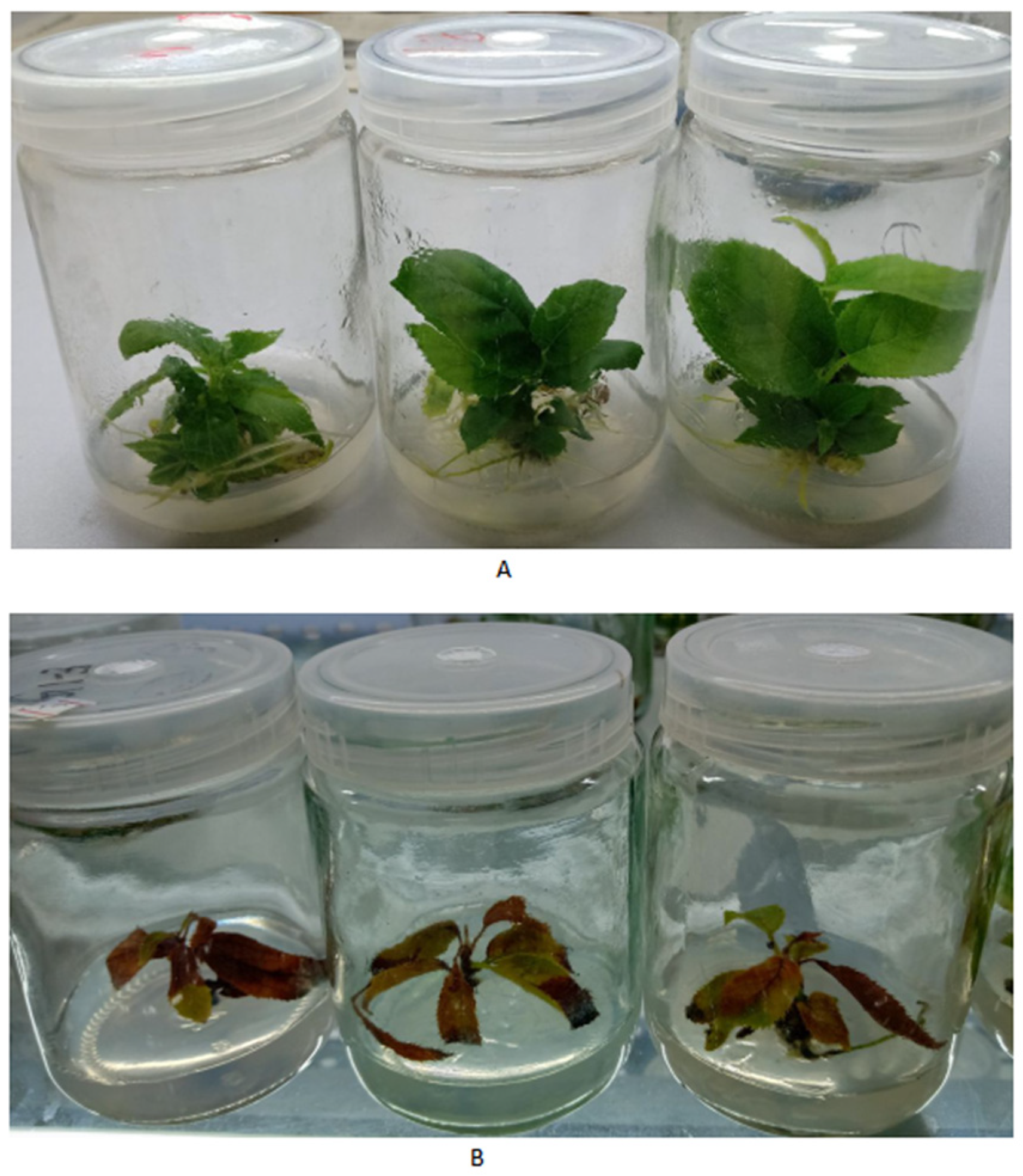
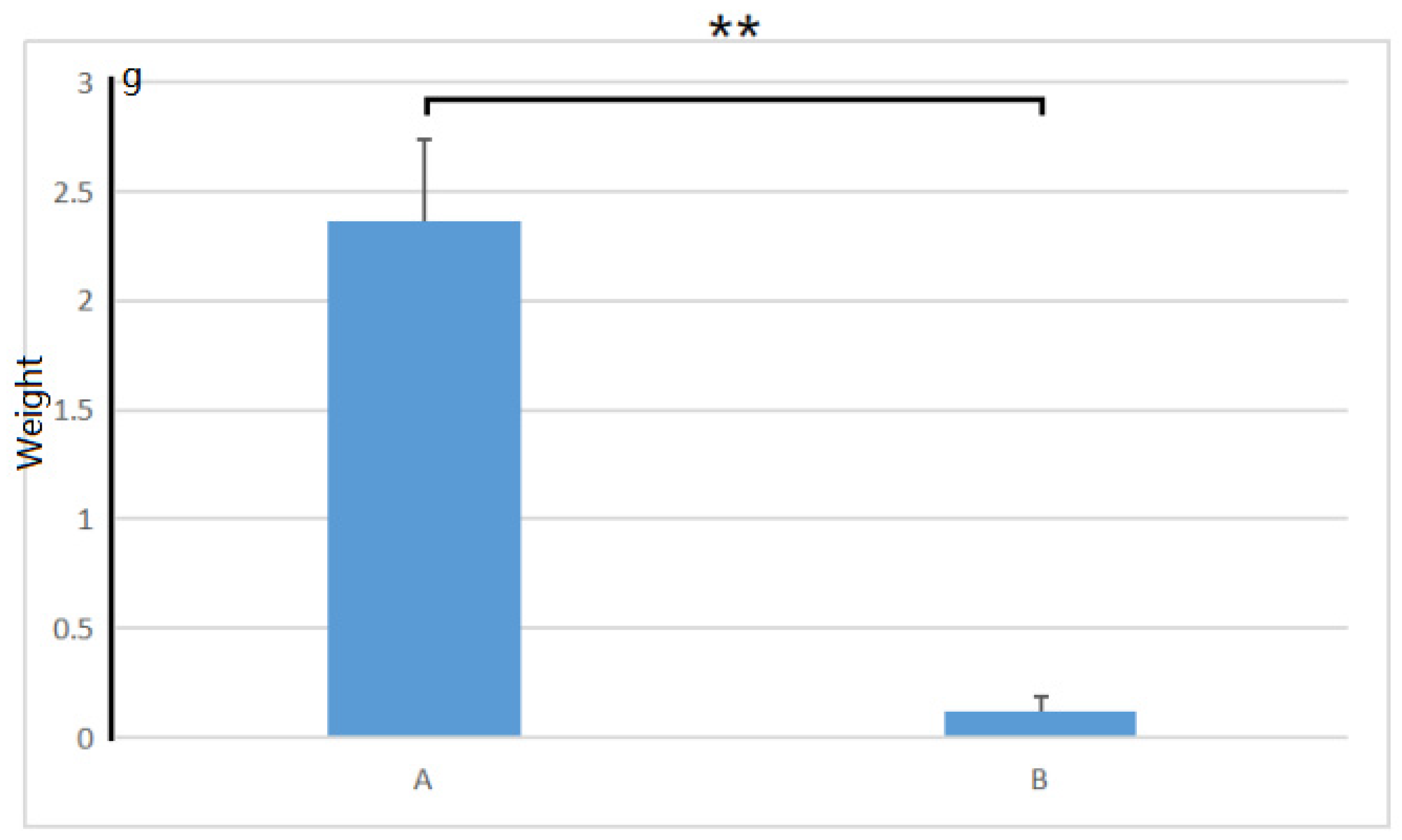
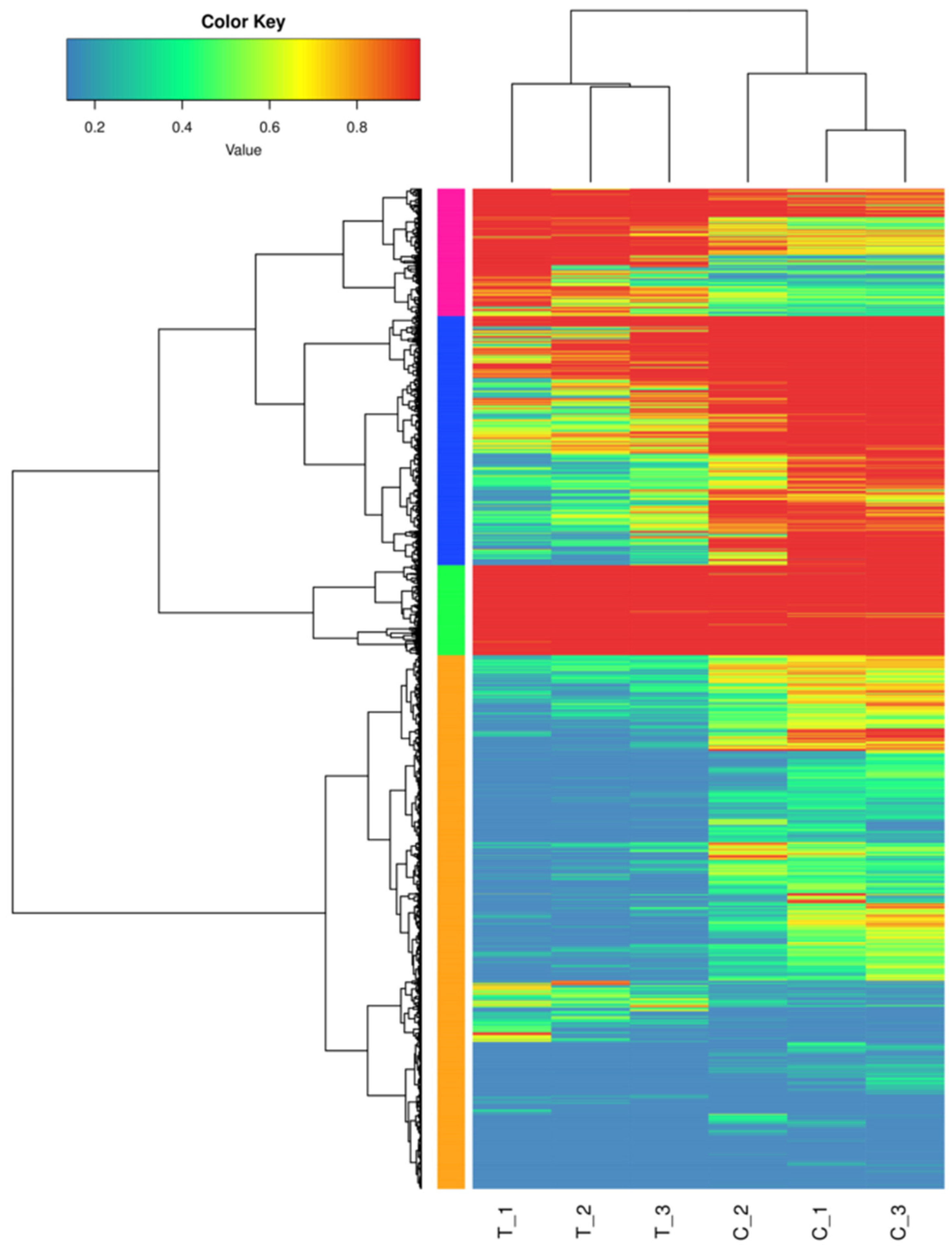
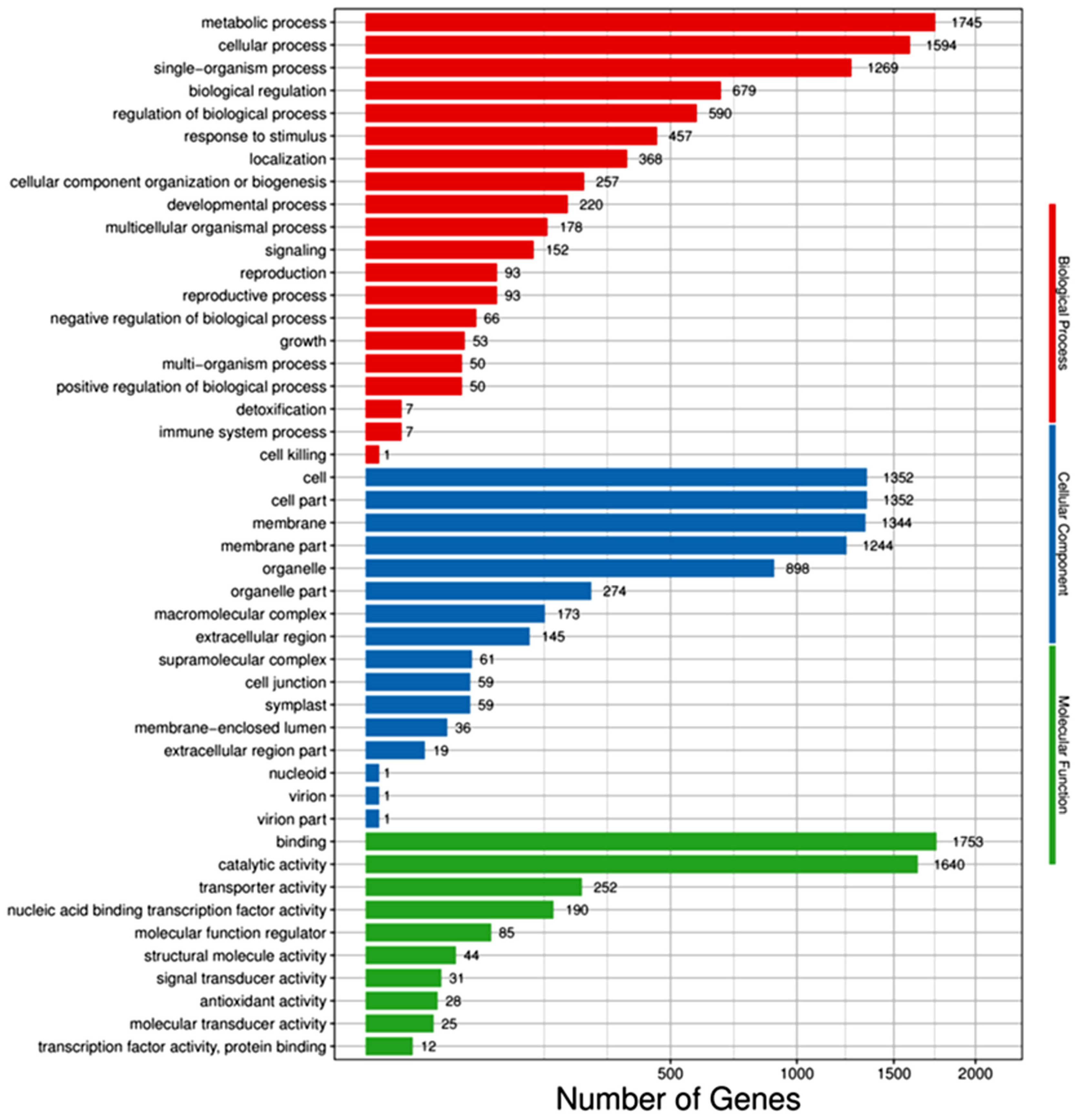

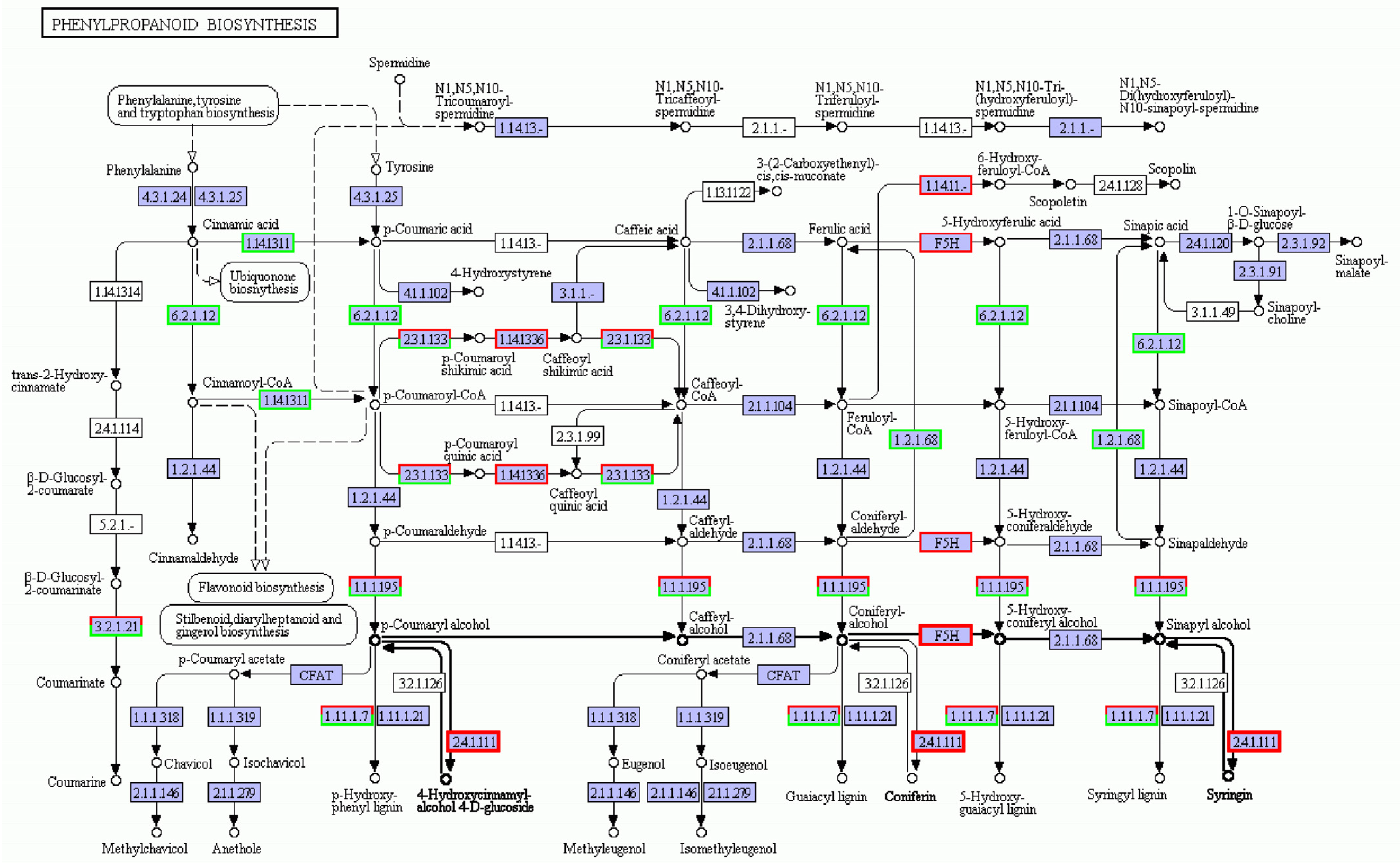
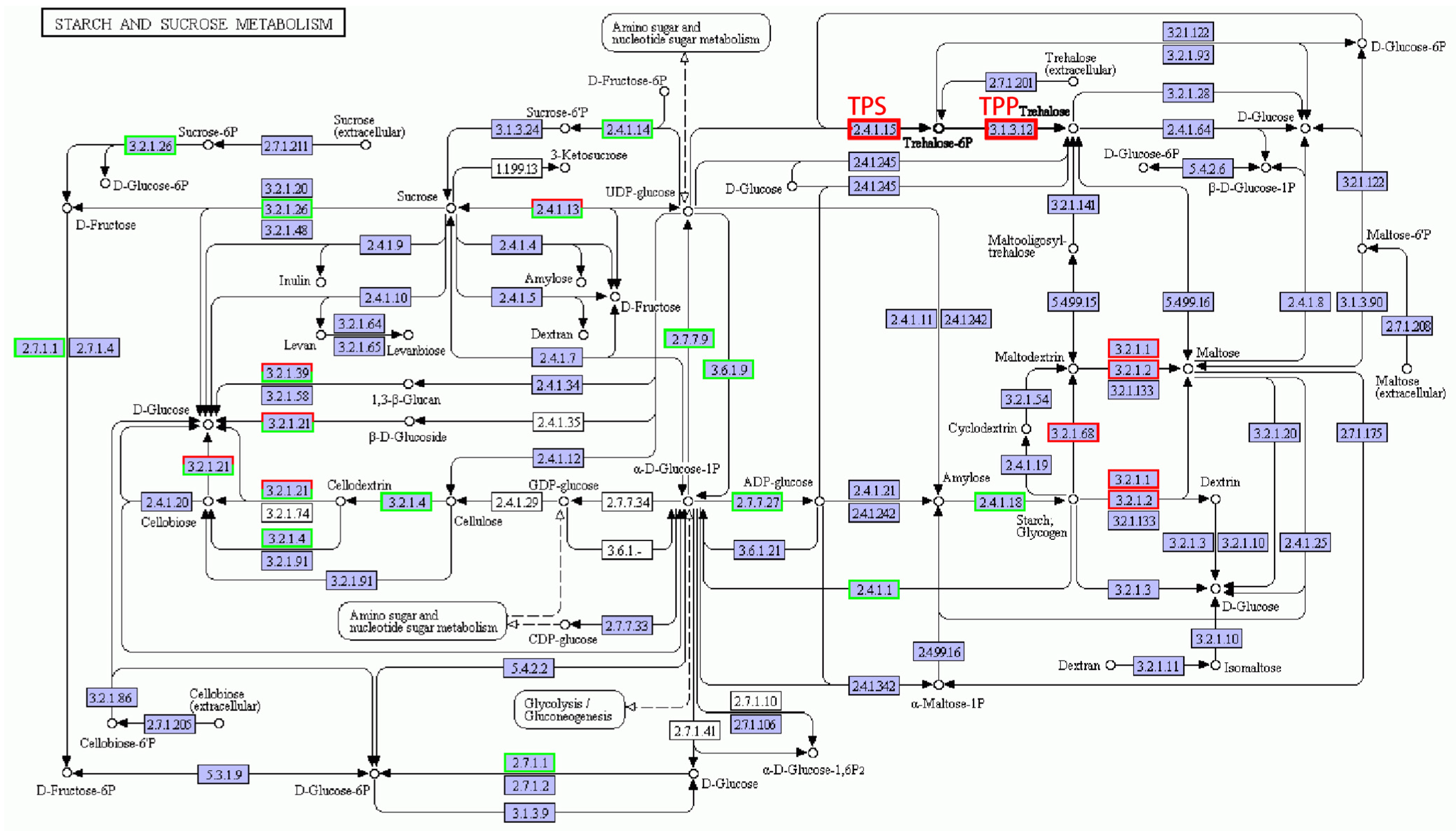
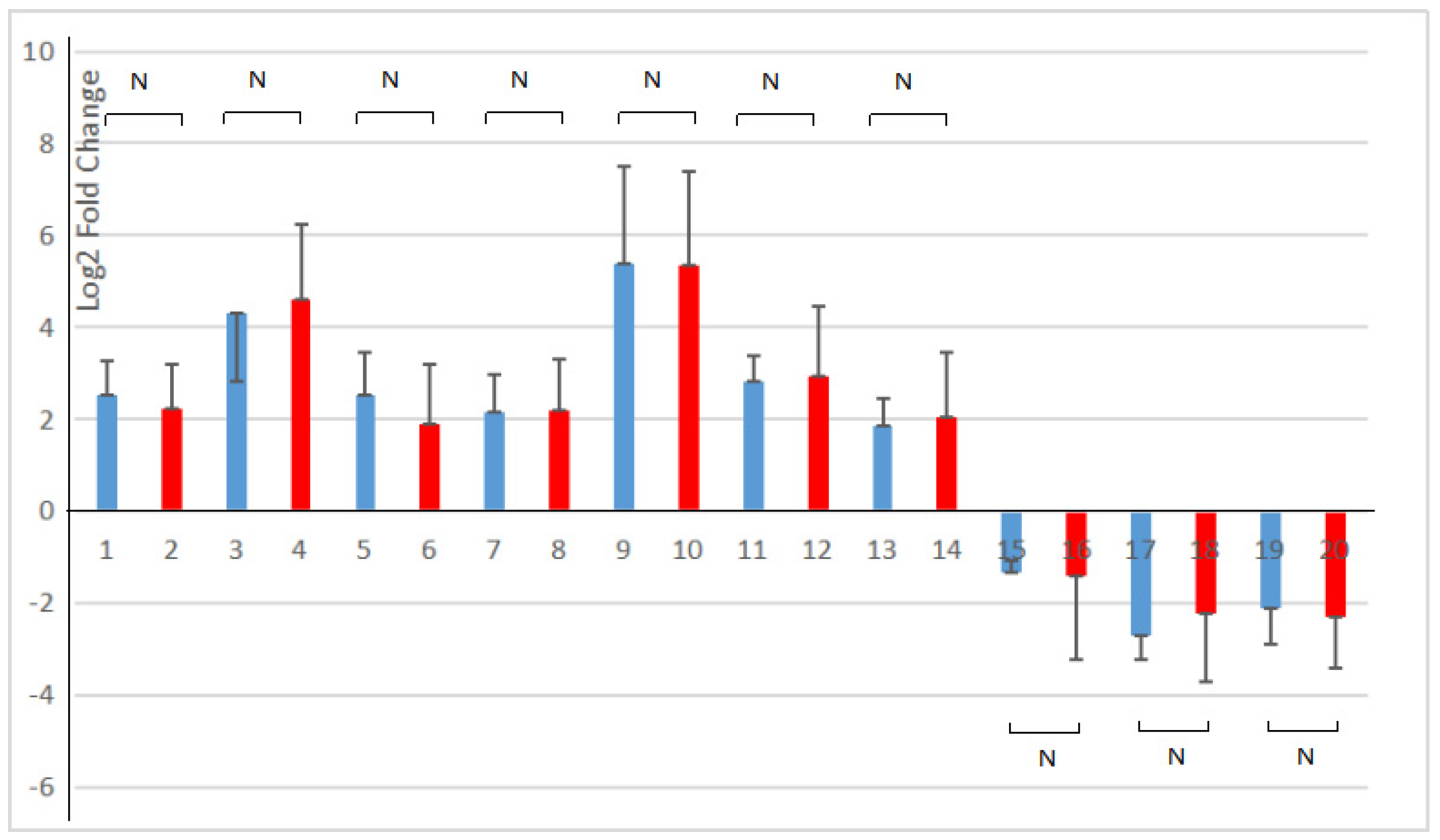
| Gene Name | Primer | Sequence (5′-3′) | Length (bp) |
|---|---|---|---|
| Elongation factor (RG) | Forward primer | ACAAGCTGGTGACAATGTGG | 127 |
| Reverse primer | CGACCACCTTCATCCTTTGT | ||
| Alpha-trehalose-phosphate synthase (CEY00_Acc20153, TG) | Forward primer | ATGACGGTACCATGATGCCT | 168 |
| Reverse primer | GACCAAGCTTTTCACACGGT | ||
| Trehalose-phosphatase (CEY00_Acc28912, TG) | Forward primer | GACAAGACCGATGAAGACGC | 194 |
| Reverse primer | CTCCTCCTTGTTCGGGACTT | ||
| Alpha-amylase (CEY00_Acc23514, TG) | Forward primer | ACTGGTGGATTGGGTAGTCG | 198 |
| Reverse primer | TGCACCCTCGTTGTATTCCT | ||
| Beta-amylase (CEY00_Acc00234, TG) | Forward primer | CTTGGAGATGGCGAAGAAGC | 150 |
| Reverse primer | TCTGTGTAGGCAAGGTCAGG | ||
| Feruloyl-CoA 6-hydroxylase (CEY00_Acc11474, TG) | Forward primer | GGTGATCAACGTCGGTGATG | 222 |
| Reverse primer | AAGTGCCTGGTGTAATCCGA | ||
| Ferulate 5-hydroxylase (MSTRG.9985, TG) | Forward primer | CGACGCATTTGAAGTAGGGG | 224 |
| Reverse primer | ACATACAACCGGGCCGATAT | ||
| Coniferyl-alcohol glucosyl transferase (CEY00_Acc06090, TG) | Forward primer | ATAAGGAGATCGCGGGTCAG | 213 |
| Reverse primer | ACGCTTCCAGTGATTTACGC | ||
| 1,4-Alpha-glucan branching enzyme (CEY00_Acc23491, TG) | Forward primer | TGGTTGATCGAATCCCAGCT | 181 |
| Reverse primer | GAGCTGCTCATCCCAACATG | ||
| UTP-glucose-1-phosphate uridylyltransferase (CEY00_Acc24242, TG) | Forward primer | AGCACCACAGATTCCGAGAA | 210 |
| Reverse primer | AGGATCTTCAGGTGTGGGTG | ||
| 4-Coumarate:CoA ligase (CEY00_Acc18560, TG) | Forward primer | ATGAGGCAGCAGGAGAAGTT | 193 |
| Reverse primer | AGCTTCGCCCTCAGATCTTT |
| Sample | Clean Reads | Base (M) | Q20 Rate | Q30 Rate | GC Rate | N Rate | rRNA Ratio |
|---|---|---|---|---|---|---|---|
| C_1 | 62,766,548 | 18,804 | 97.99 | 94.14 | 46.73 | 0 | 0.06 |
| C_2 | 61,847,584 | 17,387 | 98.03 | 94.16 | 46.57 | 0 | 0.06 |
| C_3 | 77,744,572 | 15,524 | 98.10 | 94.4 | 47.05 | 0 | 0.07 |
| T_1 | 61,046,550 | 15,000 | 98.00 | 94.28 | 46.84 | 0 | 0.07 |
| T_2 | 77,347,402 | 12,949 | 97.90 | 94.12 | 46.7 | 0 | 0.04 |
| T_3 | 81,215,912 | 9656 | 97.07 | 92.04 | 46.61 | 0 | 0.04 |
| Sample | Expressed (Gene) | Total (Gene) | The Percent of Gene Expression | |||
|---|---|---|---|---|---|---|
| 0~3 (Lowest) | 3~15 (Low) | 15~60 (Middle) | >60 (High) | |||
| C_1 | 34,641 | 36,355 | 12,468 (33.82%) | 13,608 (37.43%) | 8208 (22.58%) | 2477 (6.81%) |
| C_2 | 34,487 | 36,355 | 11,889 (32.25%) | 13,412 (36.89%) | 8227 (22.63%) | 2341 (6.44%) |
| C_3 | 34,438 | 36,355 | 11,526 (32.08%) | 13,636 (37.51%) | 7756 (21.33%) | 2454 (6.75%) |
| T_1 | 33,787 | 36,355 | 13,017 (35.31%) | 11,993 (32.99%) | 7477 (20.57%) | 2553 (7.02%) |
| T_2 | 33,791 | 36,355 | 13,303 (35.89%) | 12,399 (34.11%) | 8040 (22.12%) | 2445 (6.73%) |
| T_3 | 33,469 | 36,355 | 13,014 (35.30%) | 11,994 (32.99%) | 8190 (22.53%) | 2694 (7.41%) |
| Item | Total Number of DEGs | Number of Up-Regulated Genes | Number of Down-Regulated Genes |
|---|---|---|---|
| T-vs.-C | 5555 | 1546 | 4009 |
| T_1-vs.-C_1 | 3490 | 948 | 2542 |
| T_2-vs.-C_2 | 1467 | 293 | 1174 |
| T_3-vs.-C_3 | 1513 | 264 | 1249 |
| KEGG Pathway | Total Number of Genes | Number of Down-Regulated Genes | Number of Up-Regulated Genes | Q-Value |
|---|---|---|---|---|
| Plant hormone signal transduction (ko04075) | 126 | 101 | 25 | 3.56 × 10−17 |
| Phenylpropanoid biosynthesis (ko00940) | 70 | 40 | 30 | 3.51 × 10−12 |
| Starch and sucrose metabolism (ko00500) | 57 | 40 | 17 | 4.56 × 10−7 |
| Pentose and glucuronate interconversions (ko00040) | 41 | 30 | 11 | 1.11 × 10−7 |
| MAPK signaling pathway-plant (ko04016) | 40 | 19 | 21 | 6.51 × 10−2 |
| Plant–pathogen interaction (ko04626) | 36 | 13 | 23 | 1.00 × 10+00 |
| Cysteine and methionine metabolism (ko00270) | 33 | 23 | 10 | 2.97 × 10−2 |
| Phagosome (ko04145) | 33 | 31 | 2 | 1.19 × 10−1 |
| Aminosugar and nucleotide sugar metabolism (ko00520) | 31 | 26 | 5 | 3.62 × 10−1 |
| Biosynthesis of amino acids (ko01230) | 30 | 25 | 5 | 1.00 × 10+00 |
| Carbon metabolism (ko01200) | 26 | 17 | 9 | 1.00 × 10+00 |
| Glycerophospholipid metabolism (ko00564) | 24 | 17 | 7 | 2.88 × 10−1 |
| Pyrimidine metabolism (ko00240) | 24 | 21 | 3 | 7.53 × 10−1 |
| Flavonoid biosynthesis (ko00941) | 23 | 12 | 11 | 1.96 × 10−3 |
| Galactose metabolism (ko00052) | 22 | 12 | 10 | 1.39 × 10−2 |
Disclaimer/Publisher’s Note: The statements, opinions and data contained in all publications are solely those of the individual author(s) and contributor(s) and not of MDPI and/or the editor(s). MDPI and/or the editor(s) disclaim responsibility for any injury to people or property resulting from any ideas, methods, instructions or products referred to in the content. |
© 2023 by the authors. Licensee MDPI, Basel, Switzerland. This article is an open access article distributed under the terms and conditions of the Creative Commons Attribution (CC BY) license (https://creativecommons.org/licenses/by/4.0/).
Share and Cite
Wu, J.; Wei, Z.; Zhao, W.; Zhang, Z.; Chen, D.; Zhang, H.; Liu, X. Transcriptome Analysis of the Salt-Treated Actinidia deliciosa (A. Chev.) C. F. Liang and A. R. Ferguson Plantlets. Curr. Issues Mol. Biol. 2023, 45, 3772-3786. https://doi.org/10.3390/cimb45050243
Wu J, Wei Z, Zhao W, Zhang Z, Chen D, Zhang H, Liu X. Transcriptome Analysis of the Salt-Treated Actinidia deliciosa (A. Chev.) C. F. Liang and A. R. Ferguson Plantlets. Current Issues in Molecular Biology. 2023; 45(5):3772-3786. https://doi.org/10.3390/cimb45050243
Chicago/Turabian StyleWu, Jiexin, Zhuo Wei, Wenjuan Zhao, Zhiming Zhang, Daming Chen, Hanyao Zhang, and Xiaozhen Liu. 2023. "Transcriptome Analysis of the Salt-Treated Actinidia deliciosa (A. Chev.) C. F. Liang and A. R. Ferguson Plantlets" Current Issues in Molecular Biology 45, no. 5: 3772-3786. https://doi.org/10.3390/cimb45050243
APA StyleWu, J., Wei, Z., Zhao, W., Zhang, Z., Chen, D., Zhang, H., & Liu, X. (2023). Transcriptome Analysis of the Salt-Treated Actinidia deliciosa (A. Chev.) C. F. Liang and A. R. Ferguson Plantlets. Current Issues in Molecular Biology, 45(5), 3772-3786. https://doi.org/10.3390/cimb45050243





